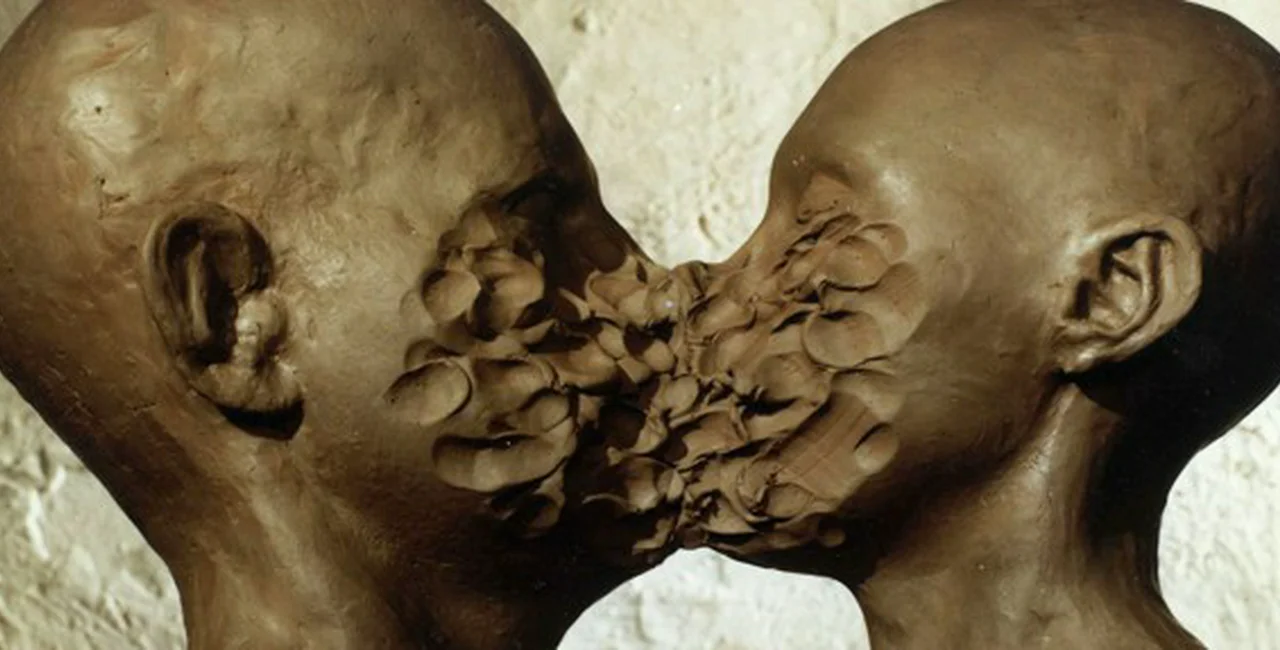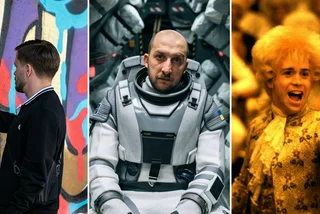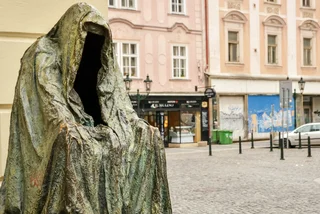In a previous article, I covered my picks for 11-20 of the best Czech animators, from famed children’s animators like Zdeněk Miler, Václav Bedřich, and Lubomír Beneš to makers of more adult-themed fare like Vladimír Jiránek and Pavel Koutský. Now it’s time to look at the top 10:
10. Jan Balej
Jan Balej doesn’t have the body of work of many of the other animators on this list, but his wonderfully bizarre 2007 feature Jedné noci v jednom městě (One Night in One City) is one of the finest pieces of Czech animation over the past 10 years: surreal, creepy, and darkly funny, it has won a number of awards at animation festivals around the world.
Balej’s second feature, Malá z rybárny (Little from the Fish Shop), is currently in production – check out a short promo reel at the film’s official website.
Jedné noci v jednom městě (2007) – clip:
9. Stanislav Látal
Beginning his career in the post-war period after WWII, Stanislav Látal was one of the pioneers of Czech animation along with colleagues Jiří Trnka, Jiří Brdečka, Hermína Týrlová, and others. Like Trnka, Látal is best known for his work with puppet animation; unfortunately, little from his five-decade career seems to be publicly available.
One of his most popular films was one of his last: Adventures of Robinson Crusoe, a Sailor from York, a 1982 feature-length adaptation of the Daniel Defoe novel that mixes stop-motion and traditional animation and stands out among the adaptations of this story. Unfortunately, the film does not appear to be available on DVD.
Adventures of Robinson Crusoe, a Sailor from York (1982) – clip:
8. Michaela Pavlátová
One of the few contemporary Czech animators to consistently produce animated shorts for adult audiences, Michaela Pavlátová’s films have garnered worldwide acclaim. Her latest short, the delightfully perverse Tramvaj (Tram), was shortlisted as one of ten films up for the 2012 Animated Short Academy Award; check it out on YouTube here. Tramvaj failed to receive the nomination, but her 1993 short Řeči, řeči, řeči (Words, Words, Words)was nominated for an Oscar.
In 2006, Pavlátová’s 1995 short Repete was selected by the Annecy Festival of Animated Film as one of the top 100 animated films – ever (Trnka’s The Hand, Švankmajer’s Dimensions of Dialogue, and Pojar’s The Lion and the Song are the only other Czech films to feature on the list). In 2008, the director’s live-action feature Děti noci (Night Owls) opened to less somewhat acclaim, though stars Martha Issová and Jiří Mádl won acting awards at that year’s Karlovy Vary International Film Festival.
Repete (1995):
7. Jiří Brdečka
Better known as a writer (he wrote the scripts for Oldřich Lipský’s Lemonade Joe and Tajemství hradu v Karpatech, and worked with directors Jiří Trnka (A Midsummer Night’s Dream) and Karel Zeman (Baron Prášil), who also feature on this list), artist-director-animator Jiří Brdečka started out as a newspaper cartoonist before directing animated shorts for friend and colleague Trnka’s Bratři v triku studio in the years following WWII. Over the next four decades, in-between his other duties, Brdečka built up an impressive array of animated shorts for the studio.
Here’s an excellent essay on Brdečka by fellow animator Gene Deitch.
Jsouc na řece mlynář jeden (1971):
6. Hermína Týrlová
The “mother of Czech animation”, Hermína Týrlová was an early collaborator of Karel Zeman; their 1946 short Vánoční sen (The Christmas Dream) won a Short Film award at Cannes. Her most famous creation might be the ant Ferda, though she directed and animated dozens of other works over a career that spanned five decades. While Týrlová never achieved the fame of some of her male contemporaries, her warmhearted puppet-animated films have remained popular with children throughout the years.
Among Týrlová’s notable filmography is Revolution in Toyland, a precursor to Toy Story in which a group of children’s toys take on a Nazi official, and the strikingly designed Modrá zástěrka (Blue Skirt).
A collection of her short films can be found on YouTube.
Uzel na kapesníku (1958):
5. Jiří Barta
A protégé of Jan Švankmajer, Jiří Barta followed in his mentor’s footsteps with a series of dark, creepy shorts that culminated in his 1985 feature-length masterpiece Krysar, an adaptation of The Pied Piper of Hamelin. Of course, this style of filmmaking isn’t exactly commercial, and Barta struggled for years to get a Golem project, started in 1987, off the ground. It left a 20-year gap – with only sporadic work – in his filmography.
In 2009, however, Barta returned with a bang: Na půdě aneb Kdo má dneska narozeniny? (Toys in the Attic), a more commercially-viable fairy tale that still retained the director’s twisted sensibility, was an absolute delight.
A terrific compilation of Barta’s works is available on Region 1 DVD.
The Vanished World of Gloves (1982):
4. Břetislav Pojar
Břetislav Pojar start his career in animation in the early 1940s, working closely with Jiří Trnka at the studio Bratři v triku before embarking on his own career as a director. Over the next six decades, Pojar would leave behind one of the most diverse and unique portfolios of any animator in the world, effortlessly moving from puppet to stop motion to traditional hand-drawn animation, employing a new style, seemingly, with every subsequent project.
Among Pojar’s best-remembered works are Lev a písnička (The Lion and the Song), which won the top prize at the very first Annecy Festival (and also featured on their list of the top 100 animated films), and the beloved children’s program Pojďte pane, budeme si hrát.
Pojar passed away last October at the age of 89. He continued working well into his eighties, with a final credit as co-director on the feature-length Autopohádky, released in 2011. In 2007, the Karlovy Vary festival featured a retrospective on his work; the fest’s website features an excellent essay on Pojar by Zdena Škapová.
Trivia: the depiction of Canadians on the TV series South Park is almost certainly a reference to Balablok, a 1972 short film Pojar made for Canada’s National Film Board which won the Palm d’Or for Best Short Film at Cannes.
Balablok (1972):
3. Karel Zeman
Karel Zeman is best known for his fantastical science fiction films in the 1950s and 60s – Cesta do pravěku (Journey to the Beginning of Time), Baron Prášil, Vynález zkázy (The Fabulous World of Jules Verne), and others – which use ingenious animation techniques for their wonderful special effects and were a clear influence on Terry Gilliam and other filmmakers around the world.
But Zeman – along with his brother Bořivoj, who later embarked on his own successful career as a live-action director, and collaborator Hermína Týrlová – was also one of the founding fathers of Czech animation, starting out with traditional puppet work in Vánoční sen (1946) and moving to the more diverse techniques in shorts like Inspiration (1949) that would define his later features.
Later in his career, Zeman would redefine his style yet again with the paper-cutout animated feature films Sindibád – pohádky tisíce a jedné noci (A Thousand and One Nights) in 1974 and Krabat (The Sorcerer’s Apprentice) in 1977.
In Prague, a newly-opened museum dedicated to Zeman’s fantastic designs and special effects can be found next to Charles Bridge in Malá Strana. Check back for a closer look at the museum on Expats.cz in the coming months.
Krabat – full feature (turn on captions for English subtitles):
2. Jan Švankmajer
To animation fans around the world, Jan Švankmajer needs no introduction. While largely overlooked by general audiences in the Czech Republic, he is (arguably) the Czech filmmaker with the largest worldwide audience. His unique style and twisted sensibility has influenced generations of animators, from Tim Burton and Terry Gilliam to The Quay Brothers and protégé Jiří Barta.
From the mid-1960s through the 80s, Švankmajer produced a series of surreal, nightmarish shorts that were inseparable from the communist regime under which they were produced; ironically, it’s amazing that the director was able to make them at all. Each one is a gem – and they’re all widely available on YouTube and other sites – but my favorite is the unforgettable clay-animated Tma/Světlo/Tma.
Švankmajer’s Dimensions of Dialogue was selected as the #3 film on the Annecy Festival’s 100 Films for a Century of Animation (which polled 30 animation specialists around the world for their picks of the most important animated films ever), topped only by 1908’s Fantasmagorie, widely considered to be the first animated cartoon, and 1914’s Gertie the Dinosaur, the first widely popular cartoon. Quite an achievement.
Post-1989, Švankmajer has focused on feature-length films; budgetary restraints have dictated the amount of animation involved in them, but the director’s style is always apparent, from the dancing meat in Šílení to the paper cutouts of Surviving Life. The 79-year-old Švankmajer is currently working on Insects, an adaptation of Pictures from the Insects’ Life by Karel and Josef Čapek, due out in 2015.
While Švankmajer’s feature films can be purchased locally from the director’s official website, his shorts are harder to come by locally; fortunately, excellent compilation DVDs have been released in regions 1 and 2 and can be purchased via Amazon.com or Amazon.co.uk (note: the UK set is much superior).
Dimensions of Dialogue (1982):
1. Jiří Trnka
Here’s the father of them all. Puppet-maker and illustrator Jiří Trnka formed the famed studio Bratři v Triku in the years following WWII with Jiří Brdečka, Eduard Hofman, and other colleagues. Over the next 20 years (a relatively short period, compared to some of the others on this list), Trnka would compile an oeuvre of puppet-animated films so successful that he was dubbed the “Disney of the East”.
The man himself was nearly as interesting as his work: a tall, imposing figure with a thick mustache and a large scar across his cheek, he was certainly not the physical presence you would expect to be making puppet movies. Throughout his filmmaking career, he also worked as an illustrator of children’s books; in 1968, he was awarded the Hans Christian Andersen Award by the IBBY.
Many of Trnka’s film projects stemmed from the novels he illustrated, including The Emperor’s Nightingale, based on the Anderson story, Shakespeare’s A Midsummer Night’s Dream, and adaptations of Božena Němcová’s Bajaja and Jaroslav Hašek’s The Good Soldier Svejk. While animation – worldwide – was mostly relegated to short subjects during this time, Trnka was producing full-length features that stacked up against the Disney films of the era.
Trnka’s last film was also one of his most important (the director himself considered it his best): 1965’s Ruka (The Hand) was a stunning indictment of the communist regime that somehow managed to slip by censors, though it was banned for decades after Trnka’s death in 1969.
Unfortunately, the availability of Trnka’s work on home video is just about nil. Image has released a Region 1 DVD, which is currently out of print; it includes The Emperor’s Nightingale, Story of the Bass Cello, The Song of the Prairie, The Merry Circus, A Drop Too Much, and The Hand. It can be had used or new from third-party sellers from about $50.
A 3-volume Japanese set which includes much more of Trnka’s work also exists; unfortunately, it only includes Japanese subtitles. It’s available locally at Terry Posters, but you’ll have to pony up some serious dough for it: 4500 CZK. (Note: this set is currently unavailable.)
Last year’s Karlovy Vary Film Festival saw a revival of Trnka’s work, and assorted screenings have popped up in Prague’s Ponrepo cinema since then. Here’s hoping a local DVD compilation is in the works.
The Hand (1965):
For such a small country, the Czech Republic is undeniably a giant in the world of animation. Here’s looking forward to what’s coming up from the next generation of filmmakers!
Related Articles












 Reading time: 9 minutes
Reading time: 9 minutes 



























